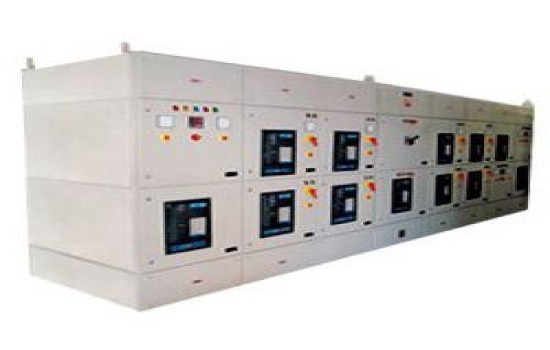Home / Complete Substation / LT SWITCHGEAR

Category Complete Substation
LT SWITCHGEAR
- Sheet steel fabricated.
- floor mounting tropical design.
- indoor type.
- Powder Coated low-tension switchgear for a three-phase, 4-wire 50 Hz, 380/415 volt AC system.
- shall be supplied complete with TP+NE Bus bar suitably sized and properly insulated.
- The panel board shall fully comply with the 15th edition IEE wiring regulations for isolation and switching.
Product Details
LT switchgear, also known as low-tension switchgear, plays a crucial role in the distribution of electrical power within various industrial, commercial, and residential settings. It serves as a protective mechanism, controlling and isolating electrical circuits, and ensuring the safe operation of the electrical infrastructure. This comprehensive guide will delve into the importance, components, types, applications, and benefits of LT switchgear.
Importance of LT Switchgear:
In any electrical distribution system, safety and reliability are of paramount importance. LT switchgear serves as a critical element in achieving these objectives. It helps regulate the flow of electricity, protects against overloads, short circuits, and other electrical faults, and ensures optimal operational efficiency. By effectively managing electrical power distribution, LT switchgear safeguards personnel, equipment, and property from potential electrical hazards.
Components of LT Switchgear:
LT switchgear comprises several key components that work in harmony to enable efficient power distribution. These components include:
Circuit Breakers: Circuit breakers are crucial elements of LT switchgear, designed to interrupt electric currents in case of overloads or faults. They provide protection by automatically opening the circuit to prevent damage to the connected equipment.
Contactors: Contactors are electromagnetic devices responsible for controlling the flow of electricity to different loads. They enable the switching on and off of electrical circuits, providing efficient control and operation of electrical equipment.
Fuses: Fuses are protective devices designed to interrupt the circuit when excessive current flows through them. They serve as sacrificial elements, preventing damage to more critical components by melting and breaking the circuit.
Busbars: Busbars are conductive bars or strips used to distribute electrical power within the switchgear. They act as electrical highways, connecting various components and facilitating the flow of electricity.
Protection Relays: Protection relays monitor electrical parameters such as voltage, current, and frequency. They detect abnormalities in the electrical system and initiate appropriate actions to protect the circuit and connected equipment.
Types of LT Switchgear:
LT switchgear can be classified into various types based on their design, functionality, and specific applications. The common types include:
Air Circuit Breakers (ACBs): ACBs use air as the arc quenching medium to interrupt electrical currents. They are suitable for low-voltage applications and provide reliable protection against overloads and short circuits.
Molded Case Circuit Breakers (MCCBs): MCCBs are compact and feature molded case housing. They offer enhanced protection against overloads and short circuits and are commonly used in commercial and industrial installations.
Miniature Circuit Breakers (MCBs): MCBs are miniature-sized circuit breakers designed for residential and light commercial applications. They provide protection against overloads and short circuits and are easy to install and replace.
Switch Disconnectors: Switch disconnectors combine the functions of a switch and a circuit breaker. They allow manual isolation of electrical circuits, providing a safe means of maintenance or repair work.
Applications of LT Switchgear:
LT switchgear finds applications across a wide range of industries and sectors, including:
Commercial Buildings: LT switchgear is extensively used in commercial buildings such as offices, shopping malls, and hospitals to ensure safe and reliable electrical distribution.
Industrial Plants: Industries, including manufacturing facilities and power plants, rely on LT switchgear to control and distribute power within their operations.
Residential Buildings: LT switchgear is installed in residential buildings to regulate and protect electrical circuits, ensuring the safety and comfort of occupants.
Infrastructure Projects: Infrastructure projects like airports, railways, and stadiums utilize LT switchgear for efficient electrical power distribution and control.
Benefits of LT Switchgear:
The advantages of using LT switchgear in electrical distribution systems are numerous:
Safety: LT switchgear provides crucial protection against electrical faults, minimizing the risk of electrical accidents and ensuring the safety of personnel and equipment.
Reliability: By effectively managing power distribution and controlling electrical circuits, LT switchgear enhances the overall reliability of the electrical system.
Operational Efficiency: LT switchgear optimizes power distribution, reducing energy losses and improving the efficiency of electrical equipment.
Maintenance and Troubleshooting: LT switchgear facilitates easier maintenance and troubleshooting by isolating faulty circuits and providing easy access for repairs.
LT switchgear is an indispensable component in modern electrical distribution systems. Its role in regulating electrical power, protecting against faults, and ensuring the safe operation of equipment cannot be overstated. By understanding its importance, components, types, applications, and benefits, users can make informed decisions when selecting and implementing LT switchgear in their electrical infrastructure.